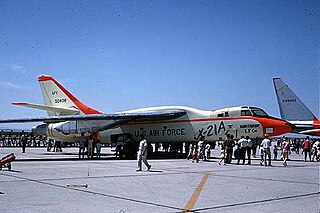Laminar means "flat". Laminar may refer to

An airfoil or aerofoil is the cross-sectional shape of a wing, blade, or sail.
X-Plane is a flight simulator produced by Laminar Research. X-Plane can be used professionally with the correct license, or used personally. A personal use desktop version is available for macOS, Windows, and Linux, while a mobile version is available for Android, iOS, and webOS. X-Plane is packaged with several commercial, military, and other aircraft, as well as basic global scenery which covers most of the Earth. X-Plane also ships with other software to build and customize aircraft and scenery. X-Plane also has a plugin architecture that allows users to create their own modules, extending the functionality of the software by letting users create their own worlds or replicas of places on Earth. This is further enhanced by the Scenery Gateway which allows users to share airports with other users and eventually the airports are included by default in the base product.

The S-300 is a series of initially Soviet and later Russian long range surface-to-air missile systems produced by NPO Almaz, based on the initial S-300P version. The S-300 system was developed to defend against aircraft and cruise missiles for the Soviet Air Defence Forces. Subsequent variations were developed to intercept ballistic missiles. The S-300 system was first deployed by the Soviet Union in 1979, designed for the air defence of large industrial and administrative facilities, military bases and control of airspace against enemy strike aircraft. The system is fully automated, though manual observation and operation are also possible. Components may be near the central command post, or as distant as 40 km. Each radar provides target designation for the central command post. The command post compares the data received from the targeting radars up to 80 km apart, filtering false targets, a difficult task at such great distances. The central command post features both active and passive target detection modes.

A leading-edge cuff is a fixed aerodynamic wing device employed on fixed-wing aircraft to improve the stall and spin characteristics. Cuffs may be either factory-designed or an after-market add-on modification.

The S-400 Triumf, previously known as the S-300 PMU-3, is an anti-aircraft weapon system developed in the 1990s by Russia's Almaz Central Design Bureau as an upgrade of the S-300 family. It has been in service with the Russian Armed Forces since 2007. The S-400 uses four missiles to fill its performance envelope: the very-long-range 40N6 (400 km), the long-range 48N6 (250 km), the medium-range 9M96E2 (120 km) and the short-range 9M96E (40 km). The S-400 was described by The Economist in 2017 as "one of the best air-defence systems currently made".
The Aerion SBJ was a supersonic business jet project designed by American firm Aerion Corporation. Unveiled in 2004, the designer sought a joint venture with a business aircraft manufacturer before a $1.2-1.4 billion development in 7-8 years. Aerion received 50 letters-of-intent before enlarging the design as the Aerion AS2 in 2014. Powered by two Pratt & Whitney JT8D-219 engines, the $80 million aircraft would transport 8-12 passengers up to Mach 1.6 and up to 4,000 nmi (7,400 km).
Aerion Corporation is an American aircraft manufacturer based in Reno, Nevada.
Boundary layer control refers to methods of controlling the behaviour of fluid flow boundary layers.

A phasor measurement unit (PMU) is a device used to estimate the magnitude and phase angle of an electrical Phasor quantity like voltage or current in the electricity grid using a common time source for synchronization. Time synchronization is usually provided by GPS and allows synchronized real-time measurements of multiple remote measurement points on the grid. PMUs are capable of capturing samples from a waveform in quick succession and reconstruct the Phasor quantity. The resulting measurement is known as a synchrophasor. These devices can also be used to measure the frequency in the power grid. A typical commercial PMU can report measurements with very high temporal resolution in the order of 30-60 measurements per second. This helps engineers in analyzing dynamic events in the grid which is not possible with traditional SCADA measurements that generate one measurement every 2 or 4 seconds. Therefore, PMUs equip utilities with enhanced monitoring and control capabilities and are considered to be one of the most important measuring devices in the future of power systems. A PMU can be a dedicated device, or the PMU function can be incorporated into a protective relay or other device.

Apollo Milton Olin Smith was an important figure in the aerodynamics field at Douglas Aircraft from 1938 to 1975 and an early pioneer in the area of Computational Fluid Dynamics.

NPO Novator is a Russian company that designs long-range anti-aircraft missiles. It was established in 1947 as OKB-8 in Sverdlovsk, became independent in 1991, and then became part of the Almaz-Antey conglomerate. It is perhaps best known for designing the 9M82 and 9M83 missiles of the S-300V SAM system.
The S-500 Prometey, also known as 55R6M "Triumfator-M", is a Russian surface-to-air missile/anti-ballistic missile system intended to replace the A-135 missile system currently in use, and supplement the S-400. The S-500 is under development by the Almaz-Antey Air Defence Concern, initially planned to be in production in 2014 it is currently targeting 2020 for deployment. With its characteristics it will be very similar to the US Terminal High Altitude Area Defense system.

JSC NPO Almaz named after A.A. Raspletin is a Soviet/Russian military R&D enterprise founded in 1947. It is the core of the Almaz-Antey holding. Headquarters – Moscow, Leningradsky av., 80.

MKB "Fakel" also known as P.D.Grushin Machine-building Design Bureau is a Russian government-owned aerospace defense corporation located in Khimki.

Power management integrated circuits are integrated circuits for power management. Although PMIC refers to a wide range of chips, most include several DC/DC converters or their control part. A PMIC is often included in battery-operated devices such as mobile phones and portable media players to decrease the amount of space required.
The SZD-7 Osa was a single-seat developmental glider aircraft that was designed and built in Poland at Szybowcowy Zakład Doświadczalny in Bielsko-Biała in 1950. Only one example was built.
The Robin X4 was an experimental French four-seat light aircraft designed and built by Avions Robin to test different wing configurations and construction materials. The X4 was a low-wing monoplane with a tricycle landing gear and powered by a 116 hp (87 kW) Textron Lycoming engine.
Missile defense systems are a type of missile defense intended to shield a country against incoming missiles, such as intercontinental ballistic missile (ICBMs) or other ballistic missiles. The United States, Russia, India, France, Israel and China have all developed missile defense systems.












